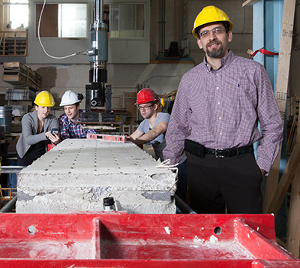Civil Engineering Professor Amir Fam calls his current research path at Queen’s “a dream come true.”
 That dream – to research and apply novel concepts for rapid construction, corrosion-resistant materials and, most recently, “bio-green” sustainable materials into Canada’s traditionally conservative construction industry – is being realized through a combination of funding from Queen’s benefactors, government and industry.
That dream – to research and apply novel concepts for rapid construction, corrosion-resistant materials and, most recently, “bio-green” sustainable materials into Canada’s traditionally conservative construction industry – is being realized through a combination of funding from Queen’s benefactors, government and industry.
Named as the first recipient of the Donald and Sarah Munro Chair in Engineering and Applied Science in 2013, Dr. Fam says he is “grateful, honoured and humbled” to have been awarded this prestigious position. Since he had just completed 10 years as Canada Research Chair in Innovative and Retrofitted Structures, the Munro Chair came at the perfect time to launch his research to the next level, he adds enthusiastically.
“This will help our team capitalize on discoveries from the past decade, taking them to a broader, more futuristic vision of sustainable structures that are energy efficient, with less impact on the environment,” says Dr. Fam.
Working on these type of cutting edge technologies provides students with the kind of hands-on, specialized training sought by top engineering companies worldwide. Graduates of the Fam lab have gone on to successful careers nationally and internationally, and have gained valuable management experience as well as technical engineering skills working with industry funders such as the Canadian multinational aerospace and transportation company, Bombardier.
The pressing global issue being tackled by Dr. Fam and his students is the deterioration of our roads, bridges and buildings due to adverse weather conditions and to aging infrastructure that requires continual repair. They are developing innovative solutions that the Munro Chair funding – along with federal and provincial government grants and industry partnerships – will enable them to refine for commercial application.
“We have major problems today with some of our traditional construction materials,” explains Dr. Fam. “The steel bars that currently reinforce concrete highways and bridges suffer badly from corrosion, particularly in harsh Canadian winters when de-icing salt is used.”
In their search for corrosion-resistant materials, his lab started testing carbon and glass fiber-reinforced polymers (FRPs) to replace steel reinforcing bars. They moved from the simple replacement of steel with lighter and stronger fiberglass to “stay-in-place” forms that facilitate “rapid construction”: building things quickly that are also more durable.
“The philosophy of rapid construction is to complete construction quickly, then get out … and not have to come back for maintenance!” says Dr. Fam. “This is now part of our vision.”
Another important part of the team’s vision is to find green, bio-based replacements for chemical-based composites that may be environmentally unfriendly and difficult to recycle. They have discovered, for example, that resin made from the juices of corn-cob cores and sugar cane will bond the fiberglass sheets used to repair existing structures. In another application, flax fibers successfully replaced glass fibers in pre-fabricated insulated sandwich panels, creating an effective alternative from renewable resources.
Because public safety concerns are paramount in the construction industry, change doesn’t come about quickly, notes Dr. Fam. As one of the few researchers today working on bio-green sustainable construction materials, he is realistic about the time required for them to become “code.”
That doesn’t dampen his enthusiasm or that of his research team, either. They are passionate about improving the strength, durability, ease of construction and environmental impact of structures we use every day – helping to make Dr. Fam’s dream come true.
Dr. Fam currently leads a postdoctoral fellow, seven doctoral students and five masters students.
The Estate of Donald Munro funded the Chair and provided an endowment to support programming and operations in Beamish-Munro Hall. Mr. Munro’s estate and in-life gifts were made in memory of his two children.
Donor-funded faculty positions – chairs, professorships and post-doctoral fellowships – enable Queen’s to recognize and attract top researchers and scholars, both from within the university and from around the world. The terms of reference for these positions, which require Senate approval, outline how the funding will be used. This may include salary, equipment costs and other resources needed by the holder. Queen’s first chair was named for Sir John A MacDonald in 1899 and was held by Adam Shortt, the university’s first full-time professor of politics and economics. Since the beginning of the Initiative Campaign, in 2006, attracting donations to support these positions has been a priority.

